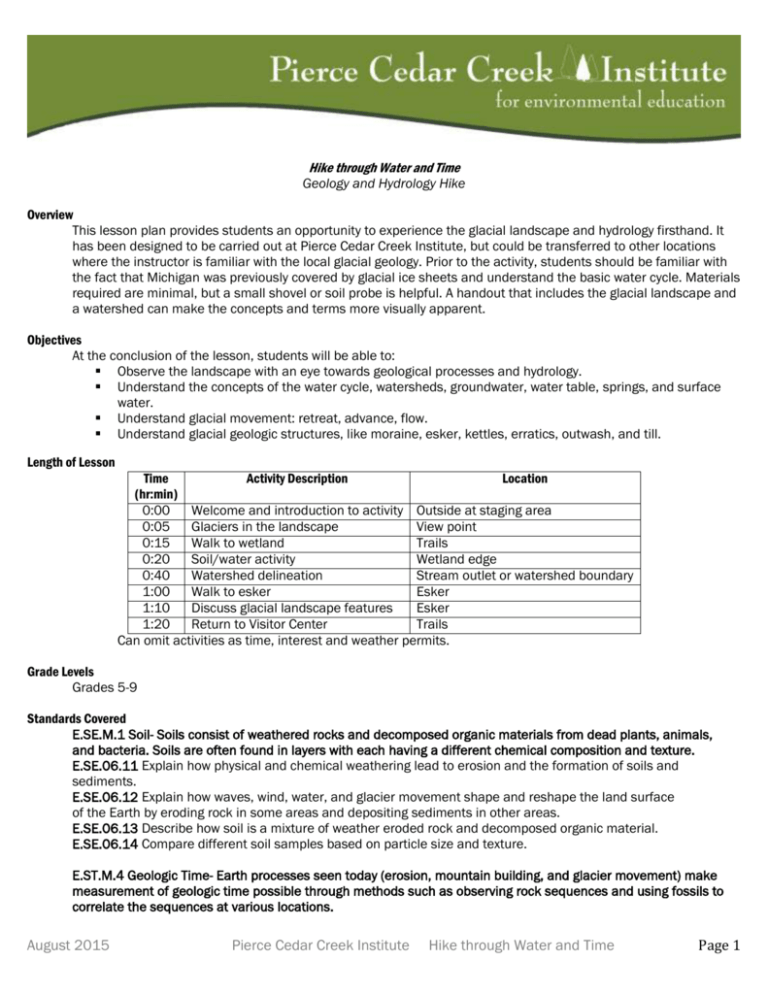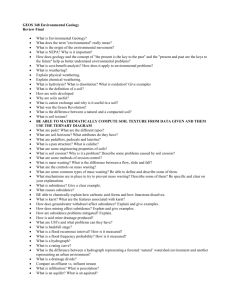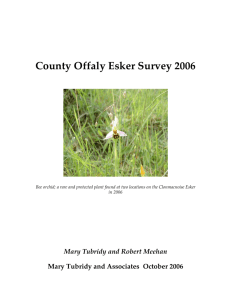Geology and Hydrology Hike
advertisement

Hike through Water and Time Geology and Hydrology Hike Overview This lesson plan provides students an opportunity to experience the glacial landscape and hydrology firsthand. It has been designed to be carried out at Pierce Cedar Creek Institute, but could be transferred to other locations where the instructor is familiar with the local glacial geology. Prior to the activity, students should be familiar with the fact that Michigan was previously covered by glacial ice sheets and understand the basic water cycle. Materials required are minimal, but a small shovel or soil probe is helpful. A handout that includes the glacial landscape and a watershed can make the concepts and terms more visually apparent. Objectives At the conclusion of the lesson, students will be able to: Observe the landscape with an eye towards geological processes and hydrology. Understand the concepts of the water cycle, watersheds, groundwater, water table, springs, and surface water. Understand glacial movement: retreat, advance, flow. Understand glacial geologic structures, like moraine, esker, kettles, erratics, outwash, and till. Length of Lesson Time Activity Description Location (hr:min) 0:00 Welcome and introduction to activity Outside at staging area 0:05 Glaciers in the landscape View point 0:15 Walk to wetland Trails 0:20 Soil/water activity Wetland edge 0:40 Watershed delineation Stream outlet or watershed boundary 1:00 Walk to esker Esker 1:10 Discuss glacial landscape features Esker 1:20 Return to Visitor Center Trails Can omit activities as time, interest and weather permits. Grade Levels Grades 5-9 Standards Covered E.SE.M.1 Soil- Soils consist of weathered rocks and decomposed organic materials from dead plants, animals, and bacteria. Soils are often found in layers with each having a different chemical composition and texture. E.SE.06.11 Explain how physical and chemical weathering lead to erosion and the formation of soils and sediments. E.SE.06.12 Explain how waves, wind, water, and glacier movement shape and reshape the land surface of the Earth by eroding rock in some areas and depositing sediments in other areas. E.SE.06.13 Describe how soil is a mixture of weather eroded rock and decomposed organic material. E.SE.06.14 Compare different soil samples based on particle size and texture. E.ST.M.4 Geologic Time- Earth processes seen today (erosion, mountain building, and glacier movement) make measurement of geologic time possible through methods such as observing rock sequences and using fossils to correlate the sequences at various locations. August 2015 Pierce Cedar Creek Institute Hike through Water and Time Page 1 E.ST.06.41 Explain how Earth processes (erosion, mountain building, and glacier movement) are used for the measurement of geologic time through observing rock layers. E.ES.M.8 Water Cycle- Water circulates through the four spheres of the Earth in what is known as the “water cycle.” E.ES.07.81 Explain the water cycle and describe how evaporation, transpiration, condensation, cloud formation, precipitation, infiltration, surface runoff, ground water, and absorption occur within the cycle. E.ES.07.82 Analyze the flow of water between the components of a watershed, including surface features (lakes, streams, rivers, wetlands) and groundwater. Materials Geology Handout with topo map and geology diagrams Soil probe Sponge for groundwater demonstration Background Local Geology Pierce Cedar Creek Institute is located in an area of end moraine (where a glacier terminated). As the Saginaw Lobe of the Laurentide glaciers melted approximately 14-15k years ago they stalled out in their retreat in this area, likely due to the underlying bedrock. Despite the glacier not advancing or retreating, they continued to flow, leaving significant glacial deposits in this area. As they melted the glaciers left behind a very diverse landscape, with a number of features that were created during this time. This includes the glacial tunnel valley, which is what Cedar Creek runs through today (a large river that flowed underneath the glaciers, flowing toward the SW). Smaller streams that flowed under the ice formed the esker that is on the property. As the glacier melted, sediment was carried in the runoff. When the stream was flowing swiftly only larger rocks were left behind. As the stream flow became slower, smaller rocks and sediment could also settle out of the flow. These sediments piled up at the bottom of the stream over time. After the ice melted, the streambed was left behind, leaving a long, narrow winding hill. The Institute also has a kame, which formed at the base of a waterfall that fell through the ice. The sediments that were in the runoff piled up at the base of the waterfall. After the ice melted away the sediments created a conical hill. The Institute has a kame on the north east side of the property. The many lakes found in this area are primarily kettle lakes. These form when sediments are deposited around blocks of ice during the melting of the glacier. After the ice melts, a hole remains, which fills with groundwater and creates a lake. Mineral soils in this area are most commonly developed from two sources, outwash and till. Outwash is the material that is carried away from the glaciers by flowing water. It is often sorted (being somewhat uniform in size). Eskers and kames both contain outwash. Other areas that contain sandy soils are often outwash. Till is the mix of material that is contained in the glacier, and which was deposited in place. Till soils are often loamy (a mixture of clay, silt, and sand). They also often contain larger rocks, called erratics, which can be three to four feet in diameter. Introduction to Hydrology Water is continuously moving around the world. This process is called the water cycle. It involves water evaporating (or transpiring from living things), condensing into clouds, precipitating back to earth as snow or rain, running off to surface water, or infiltrating into the ground where it can become part of the groundwater. In natural systems, like at the Institute, water can run off or infiltrate into the ground, depending on a number of factors. When water soaks into the ground it can become part of the groundwater. Groundwater is the state where all of the pore space in the soil is saturated with water. In this situation the water can then flow through the soil due to August 2015 Pierce Cedar Creek Institute Hike through Water and Time Page 2 gravity. The top of the saturated soil is called the water table. Groundwater may only be underground for a matter of days, but it is not uncommon for it to stay underground for years, even centuries. When the water table is higher than the soil the groundwater will emerge from the ground as a spring. Springs can be large or small, and can even be underwater if there is enough hydrostatic pressure. Once it emerges from the ground it will often begin to flow, becoming surface water. Surface water is any water that pools on the surface of the ground. It includes ponds, lakes, and streams. As water flows downhill it will meet up with other streams, each time getting slightly larger. The area that all drains into a specific body of water is called a watershed. Watersheds can be very small for small streams or ponds, or cover thousands of square miles like larger rivers. Activities of the Session Soils/Wetlands 1. Walk to wetland 2. Take soil sample in upland area. Pass the soil around to students and have students make observations. Help students recognize soil components: a. Sand – feels gritty b. Clay – will bind soil together, forms ribbons c. Silt – hard to distinguish from clay, but will not form ribbons d. Organic material – black soil, leaf litter, roots, etc. 3. Talk about connection of mineral soils to glaciers, soils derived from till and outwash. 4. Take soil sample in wetland. Pass the soil around to students and have students make observations. Help students recognize soil components: a. Muck – black organic material, very smooth b. Partially decomposed material – leaf litter, roots, etc. 5. It should be easy to distinguish the water content of the two soils, ask students where the water came from. How did it get there? Connect water levels to groundwater. Demonstrate groundwater as a state of saturation with the sponge. 6. Where does the water go? Follow wetlands down towards a stream. Introduce the term surface water. 7. Where does the stream go? – Introduce concept of watersheds and connect the small watersheds on the property to larger watersheds. (can use diagrams on handout). 8. How would water get back? Close the water cycle by helping students understand the role of evaporation and condensation in helping to move water around the earth. Glaciers At viewpoint of the glacial tunnel valley 1. Ask students about what they know about glaciers here in Michigan. Try to identify misunderstandings or confusion. 2. Describe the glacial history of the area, focusing on the glacier retreating to this area and then deteriorating in place. Describe glacial flow, retreat, and advance. a. Glacial Tunnel Valley – carved out under the glacier b. End moraine – the material in most of the upland areas c. Kettles and lakes At esker 1. Describe the shape of an esker – ask what may have formed the unique structure. 2. Describe how eskers form. 3. Point out kame, describe the shape and how kames form. Help students recognize that these forms are widespread throughout the landscape in this part of Barry County. Also, help them recognize that most features in Michigan derived from the glaciers. Different processes left different landscapes. Resources Michigan Geology from DEQ: http://www.michigan.gov/deq/0,1607,7-135-3311_3582---,00.html Online geology map, GEOWEB: http://www.michigan.gov/deq/0,4561,7-135-3311_60700---,00.html Geology of Michigan, Dorr and Eschman Extensions and Modifications Lesson could focus only on glacial geology or hydrology. August 2015 Pierce Cedar Creek Institute Hike through Water and Time Page 3 If more time is available, the hike can continue to the kame on the north side of the property. This area also gives a good view of Brewster Lake and allows students to see the kettle lake. Ask students how humans impact the water cycle through development. Assessment August 2015 Vocabulary quiz or fill in the blank utilizing the diagrams on the handout. Have students describe how an esker, kame, or kettle lake form. Have students describe how water might travel through the Institute property from precipitation to Cedar Creek. Have students delineate a simple watershed using a topo map. Pierce Cedar Creek Institute Hike through Water and Time Page 4







